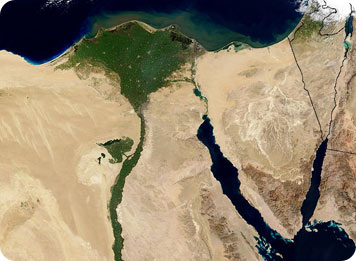For 5,000 years, the Nile River provided for the people of Egypt. Its annual flooding brought fertile soil to the fields and the Mediterranean Sea, bringing nutrients to both farms and fish.
 Satellite image of the Nile River and the Nile Delta. Credit: Wikipedia
Satellite image of the Nile River and the Nile Delta. Credit: WikipediaAfter the river was dammed in 1965, though, fishing in the Nile Delta collapsed. Without the soil-rich floodwaters, there weren’t enough nutrients. But today, the fishery has rebounded in a dramatic way. It’s still fed by the Nile, but its nutrients are generated by people.
The Aswan High Dam was built to control the Nile’s life-giving power. Year-round irrigation allowed farmers to grow three crops a year instead of one.
But without the annual flooding, there was no big gush of nitrogen, phosphorous, or other nutrients into the Mediterranean. These elements support the microscopic organisms at the base of the food chain. Without these organisms, there wasn’t enough food for the fish, so the annual take from around the mouth of the Nile plummeted.
But today, the fishing industry is catching far more than before the Aswan dam was built.
A recent study found that the rebound is caused mainly by human activity. Farmers are using more fertilizers, which are washed into the Nile. And the treated sewage from Cairo and Alexandria flows either into the Nile or directly into the sea. The fertilizers and sewage contain massive amounts of nutrients, which have boosted the marine food chain.
So the Nile continues to provide for the people of Egypt -- although with unintentional help from the people themselves.

